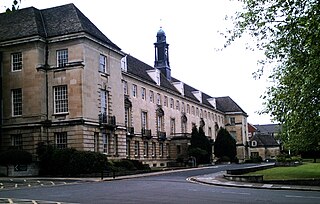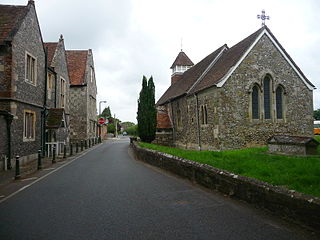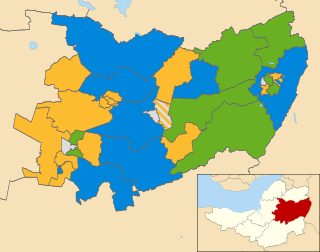Related Research Articles

Wiltshire County Council was the county council of Wiltshire in the South West of England, an elected local Government body responsible for most local government services in the county.

Salisbury is a constituency represented in the House of Commons of the UK Parliament since 2010 by John Glen of the Conservative Party.

Cornwall Council is the unitary authority for Cornwall in the United Kingdom, not including the Isles of Scilly, which has its own unitary council. The council, and its predecessor Cornwall County Council, has a tradition of large groups of independent councillors, having been controlled by independents in the 1970s and 1980s. Since the 2021 elections, it has been under the control of the Conservative Party.
Cotswold District Council in Gloucestershire, England is elected every four years.
Fenland District Council in the Isle of Ely, Cambridgeshire, England is elected every four years. Since the last boundary changes in 2015, 39 councillors are returned from 24 wards. The elections are held concurrently with the local government elections for Chatteris Town Council, March Town Council, Whittlesey Town Council, Wisbech Town Council and the other parish councils in the district, when the general election was held with district elections and the town and parish elections were pushed back to 24 May 1979.

Burnley Borough Council elections are generally held three years out of every four, with a third of the council elected each time. Burnley Borough Council is the local authority for the non-metropolitan district of Burnley in Lancashire, England. Since the last boundary changes in 2002, 45 councillors have been elected from 15 wards.
North Somerset Council is the local authority for the unitary authority of North Somerset, England. Until 1 April 1996 it was a non-metropolitan district called Woodspring, in the county of Avon.

Bemerton, once a rural hamlet and later a civil parish to the west of Salisbury, Wiltshire, England, is now a suburb of that city. Modern-day Bemerton has areas known as Bemerton Heath, Bemerton Village and Lower Bemerton.

Wiltshire Council is a council for the unitary authority of Wiltshire in South West England, created in 2009. It is the successor authority to Wiltshire County Council (1889–2009) and the four district councils of Kennet, North Wiltshire, Salisbury, and West Wiltshire, all of which were created in 1974 and abolished in 2009.
Elections to Wiltshire County Council were held on 7 June 2001. The whole council was up for election and the Conservatives held onto control.
Elections to Wiltshire County Council were held on 1 May 1997. The whole council was up for election and the result was no overall control, with the Conservatives as the largest party.

Salisbury City Council is a parish-level council for Salisbury, England. It was established in April 2009 and is based in the city's historic Guildhall. Following the May 2021 election, no party has an overall majority.
Redcar and Cleveland Borough Council is the local authority for the unitary authority of Redcar and Cleveland in North Yorkshire, England. Until 1 April 1996 it was a non-metropolitan district in Cleveland, called Langbaurgh.

Elections to the Wiltshire Council unitary authority took place on 2 May 2013. All ninety-eight seats were up for election, with each councillor being elected in a single-member electoral division, although in six of the divisions only one candidate was nominated and was thus declared the winner without elections taking place.
The second set of elections to the Salisbury City Council were held on 2 May 2013. The whole council was up for election, and the Conservative Party gained the largest number of seats.

The 2017 Wiltshire Council election took place on 4 May 2017 as part of the 2017 local elections in the United Kingdom. All 98 councillors were elected from electoral divisions which returned one councillor each by first-past-the-post voting for a four-year term of office.

The 2019 Mendip District Council election took place on 2 May 2019 to elect members of Mendip District Council in England. As Mendip District councillors are elected on a 4-year term, the next election is due to take place in 2023.
Wiltshire County Council elections were first held on 23 January 1889, with the election of the first Wiltshire County Council. Thereafter, elections were held every three years, with all members being elected on the same day. Later, the cycle was changed to one election in every four years, and the last such election was in 2005. There were also occasional by-elections, the last of which took place in February 2008.

The 2021 Wiltshire Council election took place on 6 May 2021 as part of the 2021 local elections in the United Kingdom. All 98 councillors were elected from electoral divisions which returned one councillor each by first-past-the-post voting for a four-year term of office.
References
- ↑ About your council at salisburycitycouncil.gov.uk, accessed 14 May 2015
- ↑ Keith Robinson, Returning Officer, Statement of Persons Nominated Archived 10 January 2014 at the Wayback Machine at wiltshire.gov.uk, accessed 14 May 2015
- 1 2 "City Council elections" in Salisbury Journal dated 11 June 2009, p. 3
- ↑ Tim Revell, Declaration of Result of Poll, Salisbury Bemerton dated 9 June 2009 at wiltshire.gov.uk, accessed 14 May 2014
- ↑ Tim Revell, Declaration of Result of Poll, Salisbury Fisherton and Bemerton Village dated 9 June 2009 at wiltshire.gov.uk, accessed 14 May 2014
- ↑ Tim Revell, Declaration of Result of Poll, Salisbury Harnham dated 9 June 2009 at wiltshire.gov.uk, accessed 14 May 2014
- ↑ Tim Revell, Declaration of Result of Poll, St Edmund and Milford ward, dated 9 June 2009 at wiltshire.gov.uk, accessed 14 May 2015
- ↑ Tim Revell, Declaration of Result of Poll, St Francis and Stratford ward, dated 9 June 2009 at wiltshire.gov.uk, accessed 14 May 2015
- ↑ Tim Revell, Declaration of Result of Poll, St Marks and Bishopdown ward, dated 9 June 2009 at wiltshire.gov.uk, accessed 14 May 2015
- ↑ Tim Revell, Declaration of Result of Poll, St Martin's and Cathedral ward, dated 9 June 2009 at wiltshire.gov.uk, accessed 14 May 2015
- ↑ Tim Revell, Declaration of Result of Poll, St Paul's ward, dated 9 June 2009 at wiltshire.gov.uk, accessed 14 May 2015